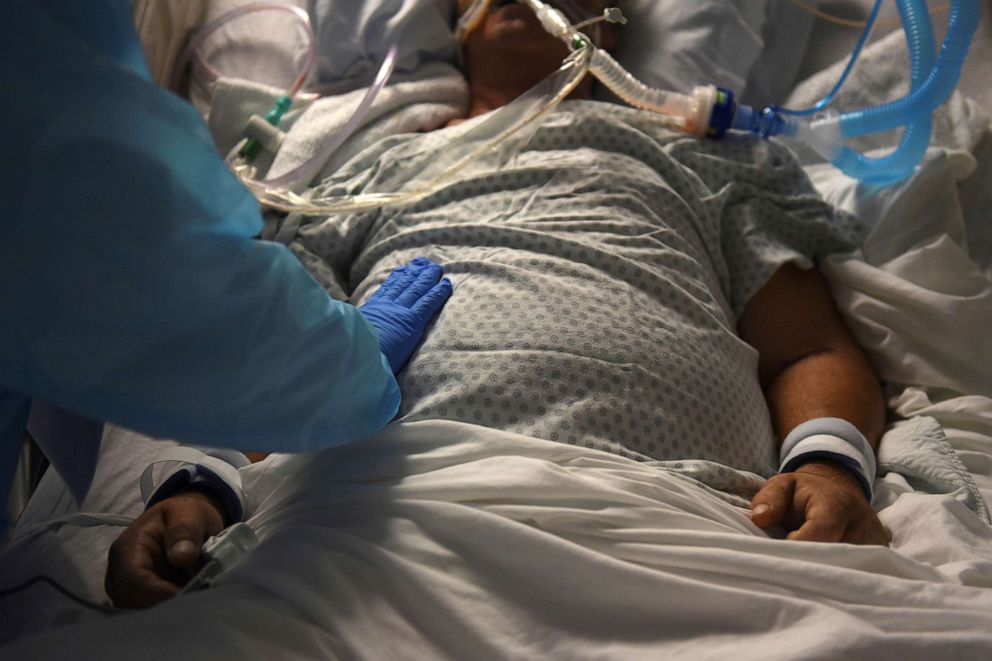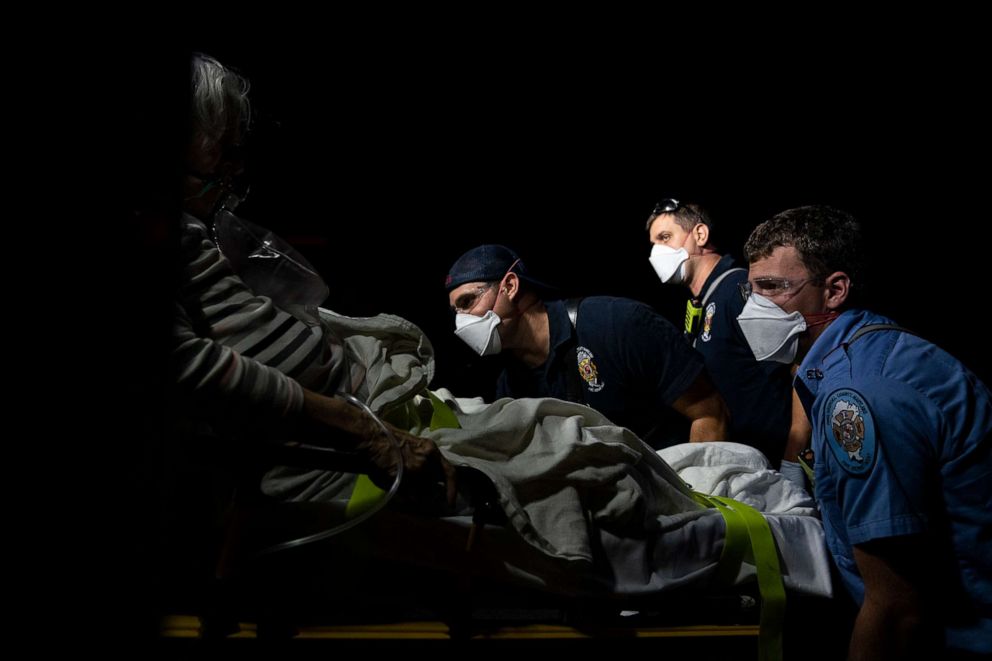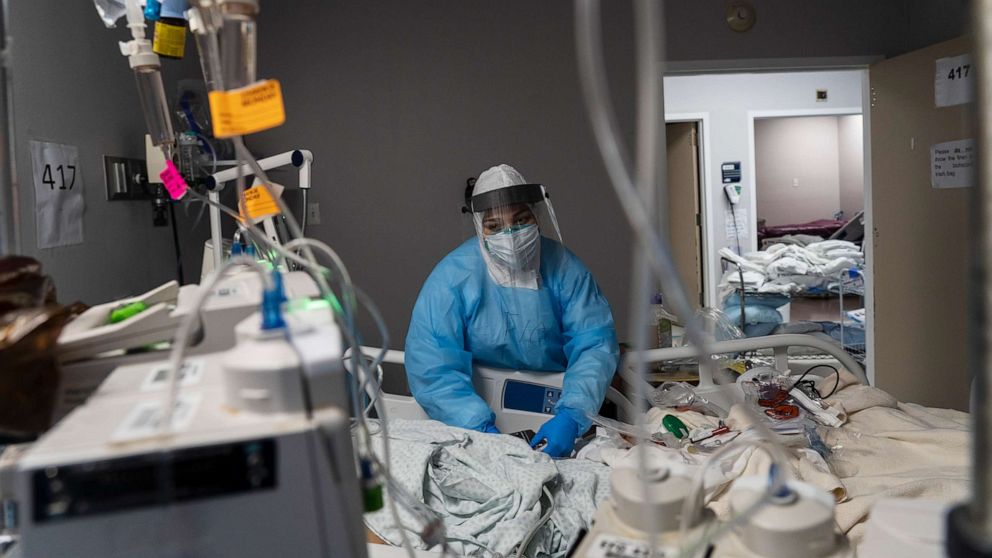 By Phaedra Singelis
By Phaedra Singelis
As the world grapples with a surge in COVID-19 cases, the pressure on medical professionals intensifies.
MORE: Coronavirus updates: Nearly 70,000 Americans hospitalized, ICUs almost out of space
Callaghan O'hare/Reuters

Tanna Ingraham, a registered nurse, talks to a ventilated patient as medical professionals treat people infected with the coronavirus disease (COVID-19) at United Memorial Medical Center in Houston, Nov. 12, 2020.
There are more than 54 millions cases worldwide. The United States is one of the worst affected countries, with more than 11 million cases and at least 246,500 deaths. Hospitals again are working to expand ICUs and handle an influx of seriously ill patients. November is on track to become the country's worst month on record for COVID-19 cases.
Alex Edelman/Getty Images

Paramedics and firefighters with Anne Arundel County Fire Department prepare to transport a patient to the hospital as first responders respond to a 911 emergency call, Nov. 10, 2020, in Glen Burnie, Md.
Although vaccines from Moderna and Pfizer are showing promise, it will be many months before enough people can be vaccinated to have an impact and protect health care workers.
MORE: Moderna announces initial Phase 3 data showing its COVID-19 vaccine is up to 94.5% effective
The U.S. is hitting record numbers of daily cases is heading toward an average of over 1,000 deaths a day. El Paso, Texas, has ramped up to handle the amount of people who have died. Inmate volunteers began helping hospitals move bodies to refrigerated trailers, and medical professionals from the military have been providing support to the Federal Emergency Management Agency.
Mario Tama/Getty Images
Inmates from El Paso County detention facility work loading bodies into a refrigerated temporary morgue trailer in a parking lot of the El Paso County Medical Examiner's office, Nov. 17, 2020 in El Paso, Texas. The inmates, who are also know as trustees, are volunteering for the frontline work and earn $2 per hour amid a surge of COVID-19 cases in El Paso.
Samantha Hall/U.S. Army
Air Force medical personnel are welcomed to the Hospitals of Providence Transmountain in El Paso, Texas, Nov. 8, 2020, by departing medical personnel of the National Disaster Medical System.
Images show long lines at drive-thru testing sites in cites across the United States, from Los Angeles to Madison, Wisconsin.
Bing Guan/Reuters
An aerial view shows vehicles queuing at a drive-thru COVID-19 testing site at the Alliant Energy Center complex in Madison, Wis., Nov. 5, 2020.
Field hospitals are being constructed to help with the overflow of patients in many cities, including Milwaukee and Worcester, Massachusetts.
Wisconsin Department of Administration via Reuters
An overhead view shows a field hospital known as an Alternate Care Facility set up at the state fair ground near Milwaukee, Wis., as cases of COVID-19 spike in the state, Oct. 12, 2020.
AFP via Getty Images
Ambulances line up at the entrance of the Intermountain Medical Center emergency room to drop off patients in Murray, Utah, Nov. 11, 2020.
Utah hospitals are expanding their ICU beds as capacity surges above 85%, nearing a crisis mode. “We are committed to doing whatever it takes to avoid crisis mode,” Dr. Mark Ott, medical director of Intermountain Health Center, told ABC affiliate KTVX in Salt Lake City. “Who gets what beds and who gets what resources?” Ott asked. “That’s the point we never want to be in because that is a rationing of care.”
John Hart/Wisconsin State Journal via AP
Bags of personal protective equipment for staff attending to patients in a COVID-19 treatment unit at UW Health in Madison, Wis. hang on a wall, Nov. 5, 2020. The hospital had four wings for coronavirus patients, but to meet growing demand, it added another wing.
Once again, nurses and doctors are reusing masks and reporting shortages of personal protective equipment.
Hiroko Masuike/The New York Times via Redux
People wait in line outside a CityMD urgent care clinic to get tested for the coronavirus in New York, Nov. 11, 2020.
States are increasing restrictions and considering a return to lockdowns. New York City, where cases surged early in the pandemic, is threatening to close down schools as the infection rate nears the 3% threshold.
Go Nakamura/Getty Images
Medical staff treat a patient suffering from the coronavirus disease in the COVID-19 intensive care unit (ICU) at the United Memorial Medical Center (UMMC), Oct. 31, 2020 in Houston.
Nearly 70,000 people are hospitalized in the U.S. The virus continues to disproportionally impact Americans of color.
MORE: Biden seeks window on vaccine plans as Trump stalls handoff
Go Nakamura/Getty Images
A medical worker treats a patient suffering from the coronavirus disease in the COVID-19 intensive care unit at the United Memorial Medical Center, Oct. 31, 2020, in Houston.
Although treatment has improved, doctors and nurses are struggling to keep up as patients fill the hospitals.
The U.S. is not alone, as cases resurged in Europe and Russia and continue to rise in India and parts of South America.
Natalia Kolesnikova/AFP via Getty Images
Patients fill a temporary hospital for coronavirus patients at the Sokolniki Exhibition and Convention Center in Moscow on Nov. 9, 2020.
Yevgeny Sofiychuk/TASS via ZUMA Press
People wait to enter Omsk's City Hospital No 2 in Omsk, Russia, Nov. 5, 2020, amidst an influx of patients due to the COVID-19 pandemic, in a photo released by the Russian state news agency.
In Moscow, a convention center has been transformed into a temporary hospital for patients suffering from the virus. And in Omsk, Russia, waiting rooms overflowed, leaving people to wait outside.
Emilio Morenatti/AP
A doctor holds the hand of a COVID-19 patient in critical care in Barcelona's Hospital del Mar the Intensive Care Unit, Spain, Nov. 5, 2020.
In Spain, one of the hardest hit countries in the spring, ICUs once again filled up, and the government reimposed restrictions, helping relieve some of the pressure on the hospitals.
Ignazio Marchese/EPA via Shutterstock
Ambulances line up outside of the COVID-19 hospital in Partinico, near Palermo, Italy, Nov. 5, 2020.
As lines of ambulances and cars with patients lined up outside hospitals in Italy, medical staff attended to sick patients as they waited in their cars, with some being administered oxygen.
MORE: Report: Belgian nursing homes failed patients amid pandemic
Laporta Salvatore/IPA via Newscom
Medical staff assist suspected cases of Covid-19 arriving by car and ambulance awaiting available beds outside the Cotugno Infectious Disease Hospital in Naples, Italy, Nov. 12, 2020.
Fabio Frustaci/EPA via Shutterstock
Medical staff rest while waiting to deliver a patient at the emergency room at Policlinico Gemelli Hospital in Rome, Nov. 12, 2020.
Health care workers once again held demonstrations to urge their governments to increase staff and provide protective equipment to meet the increase in demand.
Yves Herman/Reuters
A health worker wearing a protective face mask attends a protest to urge the government to increase staff as hospitals fill with patients suffering from the novel coronavirus disease, at the CHIREC Braine l'Alleud-Waterloo hospital in Braine l'Alleud, Belgium, Nov. 5, 2020.
Sakis Mitrolidis/AFP via Getty Images
People line up for free COVID-19 rapid tests on the waterfront of Thessaloniki in Greece on Oct. 29, 2020.
In Liverpool, England, where deaths surged in October and lockdowns resumed, soldiers were called to help with the first citywide trial of coronavirus testing in an attempt to prevent hospitals becoming overwhelmed.
Carl Recine/Reuters
Soldiers stand for two-minutes of silence for Armistice Day at a coronavirus disease testing center in Liverpool, England, Nov. 11, 2020.
Switzerland was preparing for a second wave as cases surged in Europe and the Associated Press reported 32 cases among the staff working at the World Health Organization's headquarters in Geneva, where even the most strict hygiene protocols were not enough to spare employees from the raging pandemic.
Jean-christophe Bott/EPA via Shutterstock
Hospital beds are prepared in a corridor next to the intensive care unit at the University Hospital in Lausanne, Switzerland, Nov. 6, 2020.


